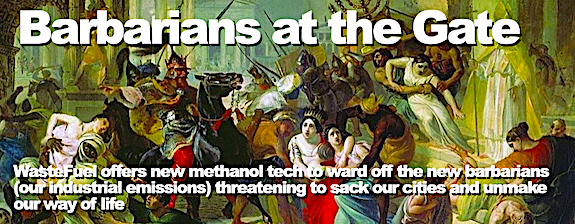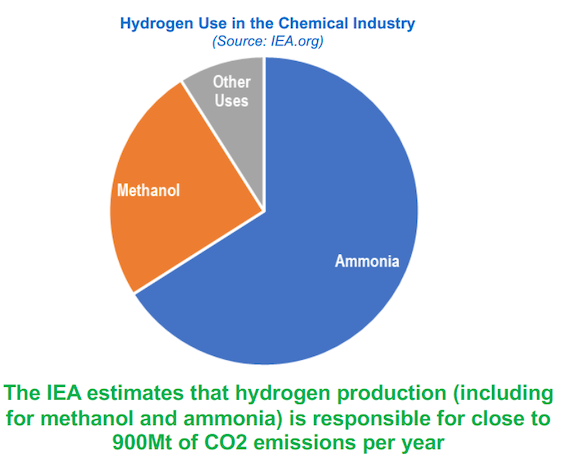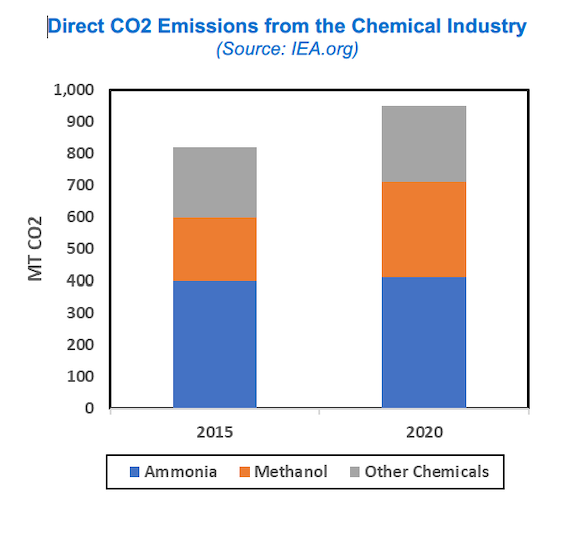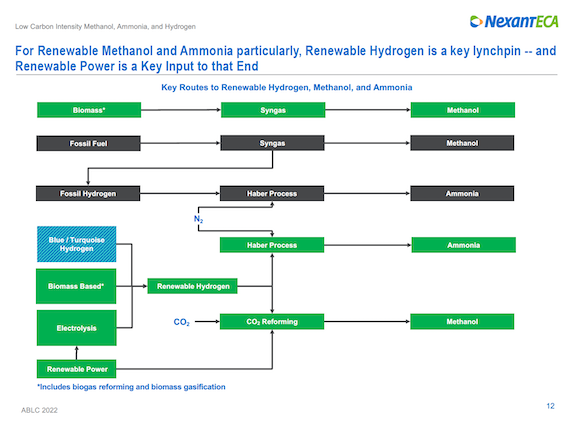Barbarians at the Gate: WasteFuel offers new methanol tech to ward off the new barbarians of industrial emission

From New York and the stages of ClimateWeek therein arrives news that WasteFuel, which would not surprise you to learn makes fuel from waste, has developed and is offering a new technology, their Methanol Module. We’ve been hard at work over the past months highlighting the advantages of methane as a feedstock, intermediate and end product — this news is a refreshing reminder that methanol is an important platform molecule too, and a bio-opportunity of such importance that when NexantECA listed it’s Top 7 Green Chemicals for the 2020s. methanol was on this list.
Methanol: Massive emissions source, large markets, and proven chemistry, says NexantECA
As Nexant’ECA’s Sarah Boisvert explained: “A shift has occurred focusing on sustainability, now what matters is emissions reduction, not bio-based content. This opens up a range of new feedstocks and solutions we can consider. Though there exist some market uncertainties around the premium potential for green / blue / bio –methanol, targeting improved emissions from the methanol industry will become very important in lowering the carbon footprint of the chemicals industry as a whole. Conventional methanol production starts with syngas; sustainable syngas can drop in to conventional processes and can be sourced from Biomass / MSW gasification or Captured CO2 and green hydrogen. Carbon capture is also a low-barrier way to improve emissions in a conventional methanol plant.”
More about methanol from Wolf Steve Slome
One of our Due Diligence Wolfpack, also working at NexantECA, Wolf Steve Slome, is bullish on methanol, putting it alongside ammonia and hydrogen as primary opportunities for development, Why? He points out: Methanol, Ammonia, and Hydrogen are the largest contributors of emissions from the chemical industry – ethylene, propylene, and related chemicals are the lions share of the rest. Here are two charts he shows that make the point on emissions — and as industry moves in Net Zero activities to abate those emissions, these molecules become a target.


Slome adds, “Methanol and Ammonia’s low prices have represented the largest hurdle to development of replacements— however as we inch closer to a time when emissions have a cost and impact on profitability, that barrier is falling rapidly”
So, there are significant markets of interest, some of which are right on the radar in the WasteFuel announce. There’s significant Interest as a Marine fuel. There’s methanol as a potential feedstock for olefins or fuels. There are routes of technological interest already commercial in Canada (MSW-based, the Enerkem route), biogas-based in Europe and there’s commercial, power-to-methanol in Iceland. One cautionary note? In some ways, Slome warns, “renewable hydrogen is a key lynchpin,” in highlighting the key routes to renewable methanol, here below.

Over at Enerkem
We mentioned Enerkem — news from the company often focuses on end-use products made from their methanol intermediate — so, SAF, ethanol, and so forth. But their core technology converts MSW to methanol. For the latest, see our Top Story from this spring. “Enerkem, Nova chart new path from waste plastic to Circularity,” here. Or, the news from last fall that “Enerkem achieves major breakthrough converting forest biomass to SAF,” here. . Or the intriguing news from earlier last year that Shell “will take a 40% interest in the Enerkem Varennes project in Quebec.
Back to the WasteFuel solution
At its heart, it’s about modularity. The modular design of the process means it can be built efficiently where waste is located and scale production efficiently and rapidly.
The WasteFuel Methanol Module is designed to produce up to 100 metric tons per day of fuel grade methanol from a variety of waste sources including landfill gas and biogas from anaerobic digestion. The process is designed in a modular fashion to improve the overall utilization of resources and allow for cost-effective, quick scaling. The company has filed a provisional patent application directly related to the novel approach and unique configuration. The process is engineered to simultaneously wet and dry reform to convert waste into green methanol. The technology will be available for licensing meaning even greater potential for adoption and decarbonization.
When utilized at a commercial scale the WasteFuel Methanol Module will produce green methanol fuel that can achieve up to 90% reductions in CO2 and other greenhouse gases and pollutants compared to conventional fuels. WasteFuel aims to produce green methanol that can be used in a variety of markets including shipping, marine transport, and petrochemicals, as well as to license its proprietary process to customers across markets, such as waste owners, biorefinery developers, and petrochemical companies.
The Maersk partnership, and potential customers
Existing WasteFuel Methanol efforts include a commercial-scale partnership with Maersk, who has announced their intent to purchase 30,000 tons per year of WasteFuel’s bio-methanol. Shipping companies including Maersk, CMA CGM, COSCO, Stena Line, and Proman have committed to using methanol to power their vessels
The Bottom Line
Jaded, cynical, “seen it all” industry observers get a tear in the eye when the topic of methanol arises. They see huge potential for emissions mitigation, and see that the era where the low prices for methanol were an insurmountable barrier to development may be drawing to its close. Emissions are the new Barbarians and the Barbarians are at the Gate. Methanol’s moment may well be arriving.
Reaction from the stakeholders
“Green methanol is critically important in decarbonizing global shipping and the supply chains of companies who depend on it. There is also a vast market for green methanol in the petrochemicals space. The WasteFuel Methanol Module will allow WasteFuel and companies who license the technology to convert municipal waste more efficiently into green methanol around the world,” said Trevor Neilson, Co-founder, Chairman and CEO of WasteFuel. “Consumer product companies who have made net zero commitments will not be able to meet them without a dramatic expansion of green methanol supply,” Neilson added.
More about WasteFuel
WasteFuel investors include Maersk, Marc Benioff’s TIME Ventures, i(x) Net Zero, NetJets, Prime Infra, Guy Oseary, and Aileen Getty. More on the company here.
Category: Top Stories















